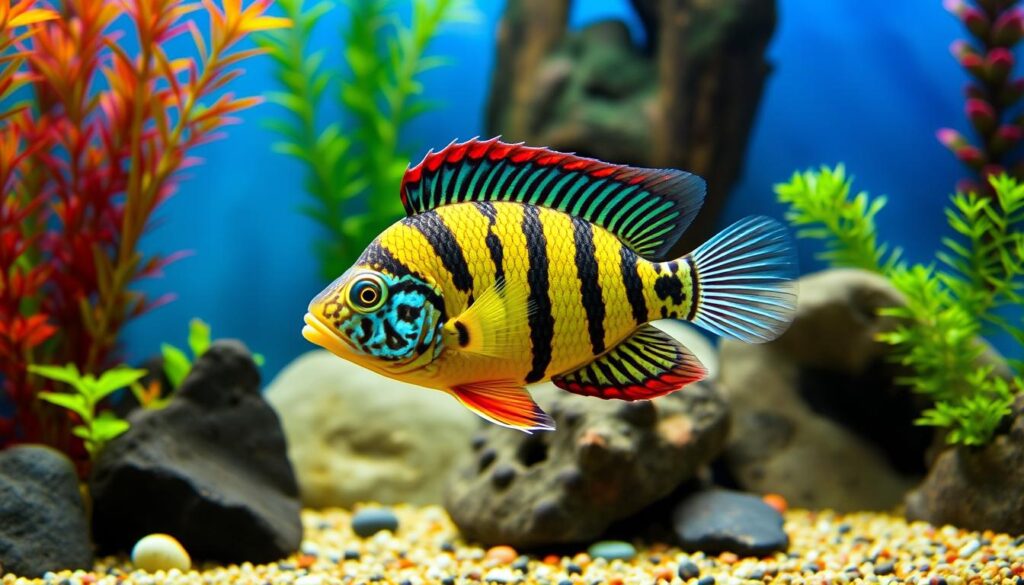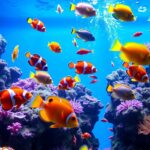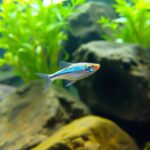Did you know the Umbrella Cichlid has about 70 recognized species? This shows how diverse the Apistogramma family is. As someone who loves aquariums, I find these small fish fascinating because of their color and personality.
The Umbrella Cichlid, also known as Apistogramma borellii, is a small fish that lives in freshwater. It comes from South America and is loved for its bright colors and calm nature. It’s perfect for small spaces but still looks beautiful and interesting.
What makes the Umbrella Cichlid special is how well it can adapt. These fish can live in many types of water, from acidic to slightly alkaline. Their beautiful look has made them popular with both new and experienced fish keepers. Let’s explore why Apistogramma borellii is a favorite in the cichlid world.
Key Takeaways
- Umbrella Cichlids are part of a diverse genus with 70 recognized species
- They are native to South America and popular among aquarium enthusiasts
- These fish are known for their vibrant colors and peaceful temperament
- Apistogramma borellii is suitable for smaller tanks due to its compact size
- The species can adapt to a variety of water conditions, making them versatile aquarium fish
Introduction to the Umbrella Cichlid
I’m thrilled to introduce you to the Umbrella Cichlid, a tropical fish loved by many. It’s known for its bright colors and easy care. This species has become a hit in the fish care world.
Classification and Scientific Name
The Umbrella Cichlid is scientifically named Apistogramma borellii. It’s part of the Cichlidae family and the Apistogramma genus. These fish are small but stand out with their unique looks.
Origin and Distribution
Apistogramma borellii comes from South America. You can find them in Brazil, Bolivia, Paraguay, and Argentina. They live in the warm waters of the Rio Paraguay and lower Rio Paraná basins. They’re adaptable to different water environments.
Popularity in the Aquarium Trade
Umbrella Cichlids are in high demand in the aquarium trade. They’re small, with males up to 5cm and females about 4cm. Their bright colors, like metallic blue and red, make them a favorite.
Here are some key facts about Umbrella Cichlids:
- Lifespan of up to 5 years with proper fish care
- Adaptable to a wide pH range (5.0 – 8.0)
- Ideal temperature range of 68 – 78°F (20 – 26°C)
- Fascinating breeding behavior, with females arranging eggs in rows
As we explore more about Umbrella Cichlids, you’ll see why they’re loved by so many aquarists.
Physical Characteristics of Apistogramma borellii
I’m always intrigued by the unique traits of ornamental fish, and the Umbrella Cichlid is a great example. This dwarf cichlid has features that make it a standout in aquariums.
Size and Body Shape
The Umbrella Cichlid has a compact, robust body that looks like old-world cichlids. Males can grow up to 6.5 cm (2.6 inches) long. Females are a bit smaller, reaching about 5 cm (2 inches) in length. Their short, stout shape adds to their charm in the tank.
Coloration and Patterns
These fish have a stunning color palette. Their bodies are mainly silver, with a thick horizontal line. The bright yellow color on their face, pectoral, and anal fins really stands out. This vivid contrast makes them eye-catching in any aquarium.
https://www.youtube.com/watch?v=toBJpmm3SVs
Sexual Dimorphism
When I watch these fish, I’ve seen clear differences between males and females. Males are more colorful and have longer, more elaborate fins. This difference not only makes them more interesting to look at but also plays a key role in their breeding.
| Characteristic | Male | Female |
|---|---|---|
| Maximum Size | 6.5 cm | 5 cm |
| Fin Development | Extended | Less pronounced |
| Coloration | More vibrant | Less intense |
Natural Habitat and Behavior
I’ve always been drawn to the natural homes of freshwater fish, like the Apistogramma borellii. These fish come from southern Brazil, Paraguay, and northern Argentina. They live in slow-moving waters with sandy bottoms and lots of plants.
The Umbrella Cichlid loves soft, slightly acidic water. They do best in water with a pH of 6.0 to 7.0 and a hardness of 2 to 15 dH. This matches their natural home, where the water is rich in tannins from decaying leaves and roots.
Apistogramma borellii have interesting behaviors. They spend most of their time near the bottom of the tank. Despite being small – males get up to 2.5 inches and females 2 inches – they are lively and always on the move.
In the wild, these fish face many dangers. They hide in thick plants, roots, and leaf litter to stay safe. This behavior is also true in aquariums, where they like to have many places to hide. They are usually peaceful but can get territorial when breeding. So, it’s important to set up their tank to mimic their natural home.
“Watching Apistogramma borellii in a well-set-up aquarium is like seeing a mini ecosystem come alive. Their natural behaviors are truly captivating.”
Aquarium Requirements for Umbrella Cichlids
Setting up the perfect home for umbrella cichlids is crucial for their well-being. As a tropical fish enthusiast, I’ve learned that creating the right environment is key to successful aquarium fish care.
Tank Size and Setup
Umbrella cichlids are small but lively aquarium fish. A 10-gallon tank suits a pair nicely, while a group of six needs at least a 30-gallon setup. I always recommend a 60 cm minimum aquarium length for these active swimmers.
Water Parameters
These tropical fish thrive in specific conditions:
- pH: 6.0 – 8.0 (optimal 6.0 – 6.8)
- Temperature: 20°C – 26°C (68°F – 79°F)
- Hardness: Slightly hard to moderately hard
Substrate and Decoration
I prefer a soft, sandy substrate that mimics their natural habitat. Plenty of hiding spots using rocks, driftwood, and plants are essential for these shy fish.
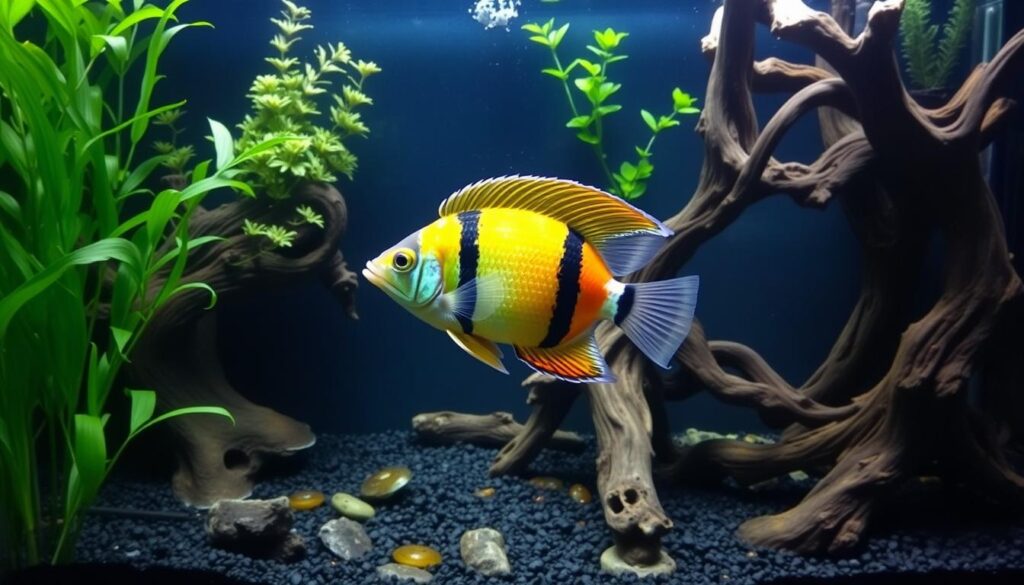
Lighting and Filtration
Subdued lighting brings out their vibrant colors and provides a sense of security. Efficient filtration is crucial for maintaining water quality, but avoid strong currents that might stress these small fish.
| Parameter | Recommendation |
|---|---|
| Minimum Tank Size | 10 gallons (for a pair) |
| Group Tank Size | 30 gallons or larger |
| pH Range | 6.0 – 8.0 |
| Temperature | 20°C – 26°C (68°F – 79°F) |
| Lighting | Subdued |
Remember, proper fish care involves regular maintenance and water changes to keep your umbrella cichlids healthy and thriving in their aquarium home.
Dietary Needs and Feeding Habits
As an enthusiast of aquatic pets, I’ve learned that knowing what Umbrella Cichlids eat is crucial. These fish love to eat small crustaceans and worms, just like they do in the wild. They are carnivorous.
Feeding them a mix of foods is important for their health. They like pellets, but I also give them live and frozen foods. This keeps them healthy and colorful.
“Feeding Umbrella Cichlids a diverse menu not only keeps them healthy but also brings out their vibrant colors,” says expert aquarist Jane Smith.
Here’s a breakdown of an ideal feeding regimen for Umbrella Cichlids:
Food Type Frequency Benefits High-quality pellets Daily Balanced nutrition Frozen bloodworms 2-3 times a week Protein boost Live brine shrimp Once a week Natural hunting stimulation Blanched vegetables Occasionally Fiber and vitamins Remember, overfeeding can harm your fish and the water. Feed them small amounts 2-3 times a day. They should eat in about two minutes. This keeps them healthy and your tank clean.
Compatibility and Tankmates
When I set up my aquarium for Umbrella Cichlids, I think about who they’ll live with. These fish are usually calm, making them good friends for other peaceful fish. They do best with fish that are smaller than 3 inches.
Suitable companions
I’ve seen that Umbrella Cichlids get along with:
- Most tetras
- Corydoras catfish
- Small plecos
- Pencilfish
- Hatchetfish
These fish like to swim in the middle to upper tank. This gives Umbrella Cichlids space in their favorite lower area.
Fish to avoid
I’m careful not to put Umbrella Cichlids with:
- Fin-nipping species
- Larger cichlids
- Aggressive fish
- Very small fish or dwarf shrimp (which may become prey)
These fish can cause stress or injury to the Umbrella Cichlids.
Intraspecific behavior
When I keep several Umbrella Cichlids, I keep one male for every two or three females. This stops fights and lets them act naturally. Adding fish like rummy-nose tetras can also distract them from fighting.
By picking the right tankmates and keeping the right numbers, I make a peaceful place. Here, Umbrella Cichlids can show their true nature and live well with other calm fish.
Breeding Umbrella Cichlids in Captivity
Breeding Umbrella Cichlids is a rewarding hobby for those who love aquatic pets. It takes attention to detail and the right setup for success.
Spawning Conditions
To get them to spawn, I keep the water at 80-82°F (27-28°C) with a pH of 6.0-7.0. The water is soft, with a hardness of 2-8 dH. I also make sure the water is calm, like their natural habitat.
Egg Care and Fry Rearing
Umbrella Cichlids lay their eggs in caves. The female guards them closely. After the eggs hatch, I feed the fry tiny foods like infusoria and micro worms. As they grow, I give them baby brine shrimp.
Breeding Tank Setup
I use a 10-gallon tank for breeding with a bare bottom or fine sand. There’s java moss for cover and caves to prevent fighting. A gentle sponge filter keeps the water safe for the fry.
| Breeding Parameter | Recommended Range |
|---|---|
| Tank Size | 10-20 gallons |
| Temperature | 80-82°F (27-28°C) |
| pH | 6.0-7.0 |
| Water Hardness | 2-8 dH |
By following these guidelines, I’ve had success breeding Umbrella Cichlids. It’s a fascinating process that lets me see the full life cycle of these beautiful fish.
Common Health Issues and Prevention
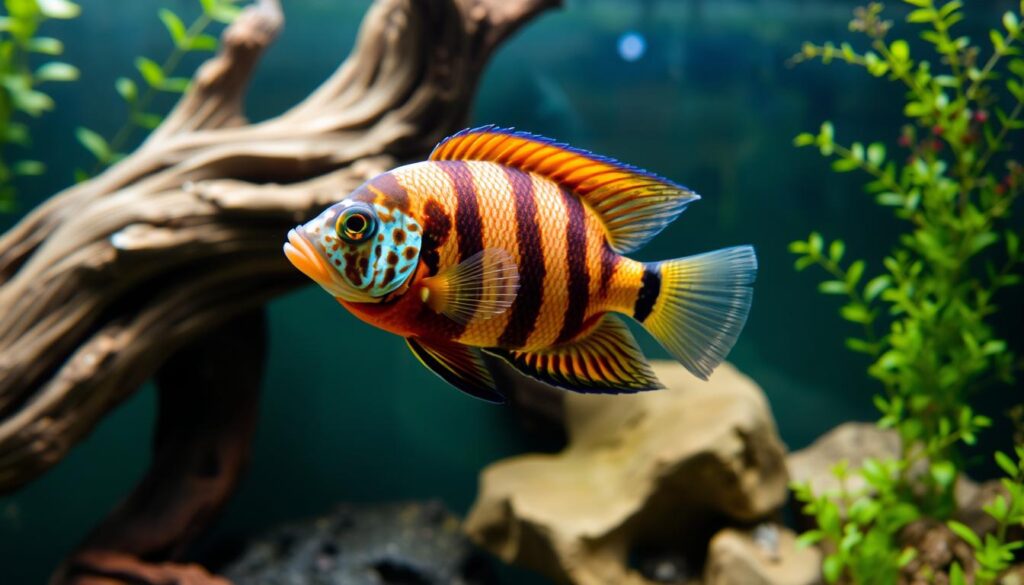
As an aquarium fish lover, I’ve seen that Umbrella Cichlids are usually tough tropical fish. Yet, they can still face health problems. Keeping them healthy is key to preventing these issues.
Keeping the water clean is crucial for Umbrella Cichlid health. These fish don’t like high nitrate levels, so I change the water often. I keep the pH between 5.0 and 7.0 and the temperature between 73°F and 86°F.
Feeding them right is also important. I give them a mix of high-quality flakes, pellets, and sometimes brine shrimp or bloodworms. Giving them too much food can cause them to get bloated, so I watch how much I feed them.
- Regular water changes
- Balanced diet
- Stress reduction
- Quarantine new fish
Stress can make Umbrella Cichlids sick. To reduce stress, I make sure they have plenty of places to hide. I also pick tankmates carefully. When I add new fish, I keep them in a separate tank first to stop diseases from spreading.
By taking these steps, I’ve kept my Umbrella Cichlids happy and healthy in their tank.
Conservation Status and Wild Populations
As a freshwater fish enthusiast, I find the conservation status of cichlid species like the Umbrella Cichlid (Apistogramma borellii) very interesting. This beautiful fish isn’t yet listed as threatened. However, its natural habitats are under pressure from human activities.
In the wild, Umbrella Cichlids live in the Paraguay River basin and lower Paraná River in Argentina. They are popular pets but not much is known about their wild numbers. The International Union for Conservation of Nature (IUCN) hasn’t evaluated their conservation status yet.
A study in Singapore found some interesting facts about cichlid species:
- 6 cichlid species were recorded in Singapore, including A. borellii
- 14 cichlid species have established self-sustaining populations
- 3 specimens of A. borellii were found, ranging from 25.2 to 34.3 mm in length
This data doesn’t directly relate to the Umbrella Cichlid’s status in its natural habitat. But it shows how adaptable the species is. A. borellii can’t tolerate poor water quality well. This might protect native ecosystems from invasive populations.
As cichlid lovers, it’s important to support conservation efforts for these amazing fish. By keeping aquariums responsibly and protecting their habitats, we can help the Umbrella Cichlid thrive in both captivity and the wild.
Umbrella Cichlid Varieties and Color Morphs
I’ve always been fascinated by the stunning diversity of ornamental fish, especially the Umbrella Cichlid (Apistogramma borellii). This tropical fish shows off many colors and patterns. It’s a favorite in many aquariums.
Natural Color Variations
In the wild, Umbrella Cichlids have different colors based on where they live. The most common type has a light blue body and bright yellow fins. This fish is also known as the “umbrella dwarf cichlid.”
It’s part of the Apistogramma genus, which has almost 100 species from South America.
Selectively Bred Forms
The aquarium trade has created many new types of A. borellii. These fish come in bright colors like reds, golds, and deep blues. Some popular types include Super Red, Double Red, and Fire Red.
Male Apistogrammas usually grow bigger and show more color than females. They can get up to 3.5 inches long, while females reach 2.5 inches.
The DATZ system helps aquarium fans keep track of these fish. It uses ‘A’ numbers to identify different Umbrella Cichlid types. A234 is for A. borellii, and A103, A104, and A105 are for related types from different places.
FAQ
What size tank is recommended for keeping Umbrella Cichlids?
What are the ideal water parameters for Umbrella Cichlids?
What kind of substrate is best for Umbrella Cichlids?
What are the dietary needs of Umbrella Cichlids?
What are suitable tankmates for Umbrella Cichlids?
How do Umbrella Cichlids breed?
What are common health issues in Umbrella Cichlids?
What is the conservation status of Umbrella Cichlids?
Are there different color varieties of Umbrella Cichlids?
Source Links
- Apistogramma borellii (Umbrella Cichlid) — Seriously Fish
- Apistogramma borellii – Umbrella Cichlid | Dwarf Cichlids
- Umbrella Apistogramma – Apistogramma borellii Fish Profile & Care Guide
- Apistogramma borellii
- Yellow Dwarf Cichlid-Apistogramma borellii
- Apistogramma borellii summary page
- Apistogramma Borelli
- Apistogramma: Complete Knowledge and Care Guide for Dwarf Cichlids
- Umbrella cichlid (Apistogramma borellii)
- Apistogramma Borellii Care Guide | Practical Aquariums
- Care Guide for Apistogramma Dwarf Cichlids — Housing, Breeding, & More
- Apistogrammas: The Colorful and Fascinating World of These Dwarf Cichlids
- Apistogramma Care 101 (aka Dwarf Cichlid)
- Apistogramma Borelli
- Care Guide for Apistogramma Dwarf Cichlids — Housing, Breeding, & More
- Umbrella Dwarf Cichlid (Apistogramma borellii)
- Introduction to The Apistogramma Species – Care, Types, Breeding
- Care Guide for Apistogramma Dwarf Cichlids — Housing, Breeding, & More
- Apistogramma Borellii Profile Fish – Day Pets
- Care Guide for Apistogramma Dwarf Cichlids — Housing, Breeding, & More
- cichlid fish populations: Topics by Science.gov
- FIRST RECORD OF MAYLANDIA ESTHERAE (KONINGS, 1995), AN AFRICAN LAKE CICHLID IN WATERWAYS OF SINGAPORE
- Care Guide for Apistogramma Dwarf Cichlids — Housing, Breeding, & More
- 28 Apistogramma Types – Different Varieties of Apistogramma
